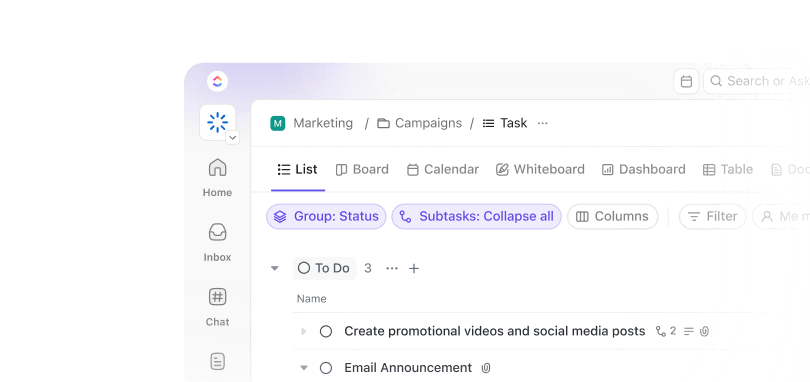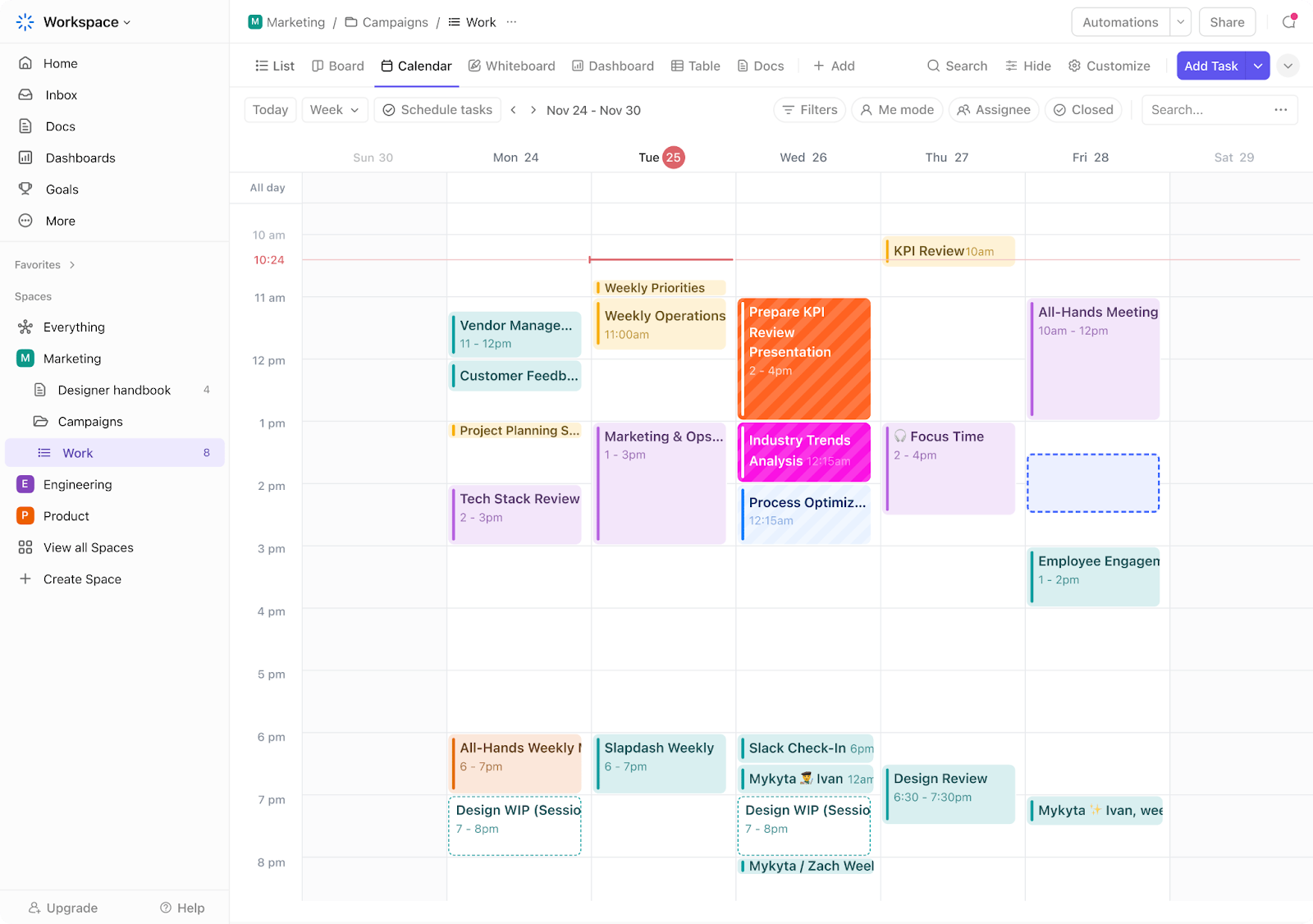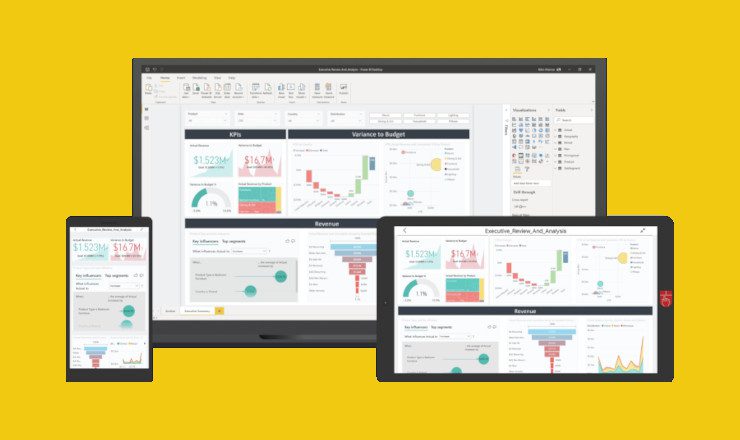When you open your calendar on Monday morning, it’s a wall of identical event blocks—you have no clue what’s urgent, what’s personal, or what requires deep focus.
Sound familiar? When everything looks the same, everything feels the same, and that’s a fast track to burnout.
A color-coded calendar changes that. It turns your schedule into a visual map where priorities stand out, context is clear, and time is easier to manage.
In this blog post, we’ll show you how to set up and manage a color-coded calendar using . Let’s get started!
How to Use a Color-Coded Calendar to Organize Your Schedule
What Is a Color-Coded Calendar?
A color-coded calendar is a visual scheduling system where different colors represent specific categories, tasks, or priorities.
Instead of viewing your schedule as a uniform list of events, color-coded notes and calendars break it down into intuitive, instantly recognizable segments.
For example, blue might represent meetings, green for personal time, red for deadlines, and yellow for creative work. Whether digital or physical, this method offers at-a-glance clarity that helps prioritize work effectively.
Benefits of a color-coded calendar
- Improves clarity and reduces mental fatigue: Your brain processes certain colors faster than text, making it easier to understand your schedule at a glance. This reduces planning fallacy and the cognitive load of scanning through every calendar entry 💙
- Enhances focus and smoother transitions: When your to-dos are grouped by color, it’s easier to stay focused and shift between activities without losing momentum. Colors affect emotions and cognition, so using the right ones can signal urgency, indicate priority, or create a sense of calm 💚
- Reveals balance (or lack thereof): A quick glance at your week can tell you if you’re overloaded or under-rested. Too many high-priority (often red) blocks may signal burnout, while a lack of restorative time (green or blue) might show you’re neglecting self-care 💛
- Supports better time estimation: Seeing recurring patterns helps you track how long tasks actually take, not just how long you think they should take. This makes future planning more realistic ❤️
- Drives smarter time management: Visually mapping out categories like meetings, deep work, admin, and rest using time-blocking helps spot imbalances and make strategic adjustments to improve both productivity and well-being 💜
🧠 Fun Fact: The idea of using a color-coded system to organize time dates back to ancient civilizations. The Maya, for instance, had a complex calendar system where different colors represented specific days and religious meanings.
How to Create a Color-Coded Calendar in
While many online calendars support color coding for calendar organization, most remain limited to basic scheduling capabilities.
That’s where stands out.
Calendar uses AI to plan your perfect schedule based on your tasks, events, and goals.
You get a personalized plan every morning that adjusts to your workload and preferences throughout the day. Meetings? No problem. It connects with Zoom, Google Meet, and Microsoft Teams so that you can join directly from the AI calendar.
And it automatically color-codes tasks based on various parameters. However, for those who want to play around with the colors, may we introduce you to Calendar View!
is the everything app for work that combines project management, knowledge management, and chat—all powered by AI that helps you work faster and smarter.
It gives you 15+ customizable views, but the Calendar View steals the show when it comes to visual planning. It lets you schedule tasks across multiple Spaces, filter by assignee or priority, and drag and drop to reschedule in seconds.
Below is a step-by-step guide to creating a highly functional color-coded calendar in .
Step #1: Set up Calendar View
Inside , head to the Space, Folder, or List where you want to set up your calendar.
Click the + View button, select Calendar, add the calendar name, and set visibility (public or private).
💡 Friendly Tip: Use color psychology to match each task with the energy it demands. Assign bold colors like red or orange to high-focus work and cooler shades like blue or green to tasks that require calm or creativity. Think of it as training your mind to recognize the mode you need to be in before you even start the task.
Once the Calendar View is created, click the Customize button in the upper-right corner. This opens a panel where you can configure how tasks appear on your calendar.
Ensure tasks have start and/or due dates so they appear in the Calendar View. You can also toggle options like:
- Show subtasks
- Show tasks from all Lists
- Show future recurring tasks (available in paid plans)
Step #2: Choose your color-coding method
There are three primary ways to color-code tasks in Calendar View. To access these options, tap on Layout options.
Here are the options you will see:
Color by Status
- In the Customize panel, select Color by → Status
- Each task will be colored based on its current status, such as ‘To Do,’ ‘In Progress,’ or ‘Complete’
- You can customize status colors via ClickApps > Task Statuses
Color by Parent List
- Select Color by → List
- This is useful when your calendar spans multiple projects or departments
- To change a list’s color, open the three-dot menu next to the list name and choose a new color
Color by Dropdown Custom Field
- This is the most flexible method. Select Color by → [Your custom dropdown field]
- This lets you color-code the calendar based on categories like task type, priority levels, or department
- You’ll need to create and configure a dropdown custom field first (we’ll cover that next)
Step #3: Develop a color key
Before exploring color usage in depth, it’s essential to create a color key for standardized reference. Assign clear meanings to each color.
For example:
🔴 Red: High priority or urgent
🟡 Yellow: In progress
🟢 Green: Completed
🔵 Blue: Meetings or admin work
🟣 Purple: Items for review
Add the key to a pinned Doc, include it in a recurring reference task, or paste it in the Calendar View description so everyone has easy access.


Use the same color logic across all views, lists, and users. This reduces confusion and increases efficiency when scanning through tasks.
🔍 Did You Know? Hospitals often use color-coded scheduling for doctors and nurses to streamline patient care. For instance, red might indicate surgery shifts, while green represents outpatient appointments.
Step #4: Add and configure Custom Fields for detailed segmentation
Dropdown Custom Fields give you even more control over how tasks appear in Calendar View. They’re especially useful when you need to color-code something more specific than status or list.


- Create a dropdown field
Open any list, click + Add Field, and select Dropdown. Name the field according to your use case—examples include ‘Task Type,’ ‘Project Phase,’ or ‘Priority.’
- Add and color-code options
Add individual dropdown values and assign each one a color. If you choose this field in the Color by settings, these will directly reflect in your calendar.
- Apply dropdown selections to tasks
When creating or editing tasks, use the dropdown field to assign the appropriate label. The selected color will show in your Calendar View, keeping your layout visually consistent and informative.
🔍 Did You Know? A Field Study of On-Calendar Visualizations looked at how different visual elements, including color, affect calendar usability. While some participants found too much color overwhelming, many said it helped them quickly distinguish between event types.
Step #5: Save and use your customized calendar
After selecting the appropriate ‘Color by’ method and configuring task visibility, click Save View to lock in your settings. This locks in your layout, filters, and color settings so you can return to the exact same view anytime.
From there, you can access it from your sidebar and reuse it as a focused, color-coded work-from-home schedule whenever you need.
📮 Insight: Nearly 35% of knowledge workers consider Monday the least productive day of the week. Accumulated emails, messages, and newer priorities that emerge during Monday standups contribute to this.
But what if you could converge all those Monday updates, tasks, meetings, and emails under a single platform and tackle them all in one go? , the everything app for work, brings it all together so you can plan, communicate, and execute without bouncing between tools.
Best Practices for Managing Your Color-Coded Calendar
A color-coded calendar is only as effective as the system behind it. Here are some best practices for managing your color-coded calendar:
Define a consistent color scheme
Allocate specific colors for particular categories, such as meetings, deadlines, personal time, and project work, to create a visual shorthand. Ensure that the color scheme remains consistent across all your calendars to avoid confusion.
Limit the number of colors
Stick to a limited palette to prevent overwhelming the calendar; typically, 4-6 colors should suffice. Choose colors that are easy to distinguish at a glance, avoiding similar shades.
Use high-contrast colors for high-priority items
Assign brighter or more vivid colors to denote high-priority tasks so they grab your attention easily. Reserve less saturated colors for lower-priority or flexible tasks.
Regularly update your calendar
Set aside time each week to review and update your calendar, ensuring all color codes are current and relevant. Adjust and reassign colors as necessary to reflect changes in priority or category emphasis.
💡 Pro Tip: Back-to-back meetings and no time to jot down what you even agreed to? ’s AI Notetaker jumps into your Zoom, Google Meet, or Microsoft Teams calls, captures the conversation, and hands you a bullet-point breakdown with tasks, deadlines, and decisions.
All that’s left for you? Assign a color, drop it in your calendar, and move on.
Incorporate personal time and breaks
Use distinct colors to mark personal time or breaks to maintain a clear boundary between work and personal life.
Sync with your devices
Ensure your color-coded calendar is synced across all devices for consistent access and updates. Check compatibility with apps you use to maintain uniformity in color-coding.
Educate your team (if applicable)
If your calendar is shared with a team, make sure everyone understands the color scheme and its significance. Provide a quick reference guide to help team members quickly interpret the calendar.
Utilize calendar features
calendar features, like reminders and recurring events, to complement your color-coding strategy. Highlight major deadlines or events using both color coding and notifications for extra emphasis.
💡 Pro Tip: Use Brain to auto-generate descriptions, titles, or task breakdowns when setting up your weekly or monthly color-coded calendar. It can also analyze your current workload and suggest more efficient time allocations based on task urgency, team capacity, and recurring trends.
Make the most of your color-coded calendar
Here are some best practices to make the most of your color-coded calendar in :
- Audit your system quarterly: Review color-coding rules every three months to ensure they still match your current workflow, priorities, and team structure. Remove outdated categories and refine as needed
- Combine with filters for precision: Use filters alongside color-coding—by Assignee, Due Date, Tag, or Priority—to create hyper-focused views. This helps isolate relevant tasks without changing your entire calendar structure
- Leverage templates: Apply monthly calendar templates to pre-structure recurring planning workflows. For day-to-day task scheduling, start with a schedule template to quickly organize and color-code routine tasks without recreating layouts each time
For instance, imagine your Monday is fully booked. Calendar reviews your task list and work-from-home schedule, then creates a plan that blocks out focus time for your most urgent work. Less pressing tasks are moved to later in the week, and a quick team sync is scheduled when everyone is available.
Calendar Planner Template
When work gets hectic, a simple calendar isn’t enough. You need a reliable system that tracks deadlines, keeps your team aligned, helps prioritize effectively, and adapts as things shift. The Calendar Planner Template is built to do exactly that.
Here are some benefits of using this template:
- Break projects into manageable steps: Divide complex initiatives into smaller tasks and spread them across your calendar
- Track key dates: Get a clear timeline to plan around and monitor progress with milestones and deadlines
- Adjust plans easily as priorities shift: Drag-and-drop tasks on the calendar, making it easy to update plans in real time
- Collaborate with clarity: Assign responsibilities, set reminders, and keep your team aligned around shared goals
🔍 Did You Know? Chronotype theory says we all have natural energy patterns—some folks do their best thinking in the morning, and others hit their peak in the afternoon. That’s why forcing everyone into the same 9-to-5 groove never really works.
Digital calendars give you the flexibility to work with your energy. And color-coding task types makes it easier to plan around your high-energy windows.
💡 Pro Tip: Connect your Microsoft Outlook Calendar with to synchronize tasks and meetings. Start with a one-way sync by grabbing your Calendar feed (ICS URL) and adding it to Outlook. You’ll see all your scheduled tasks inside Outlook.
Make Time Management Easier With
With color-coded scheduling, you’ve taken the first step toward turning calendar chaos into clarity. But with , your time management game levels up even further.
Calendar facilitates automatic time blocking and schedules important tasks according to your priorities. Paired with the interactive Calendar View, you can visualize and manage tasks across daily, weekly, or monthly layouts.
Filter by assignee, tag, or priority, and quickly reschedule with simple drag-and-drop functionality.
Need a head start? also offers templates that make setup effortless.
Sign up for for free today!


Everything you need to stay organized and get work done.















